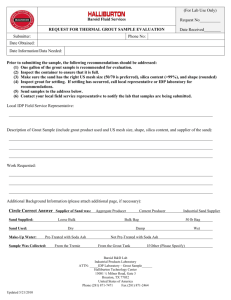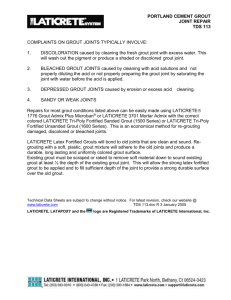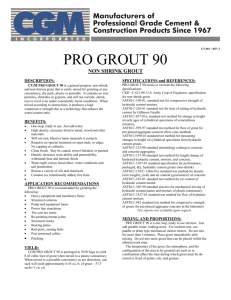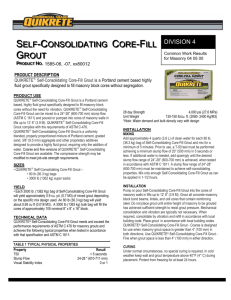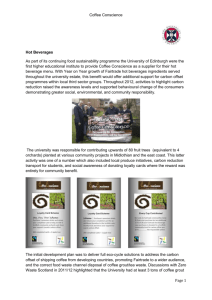grout for concrete masonry tek 9-4a
advertisement
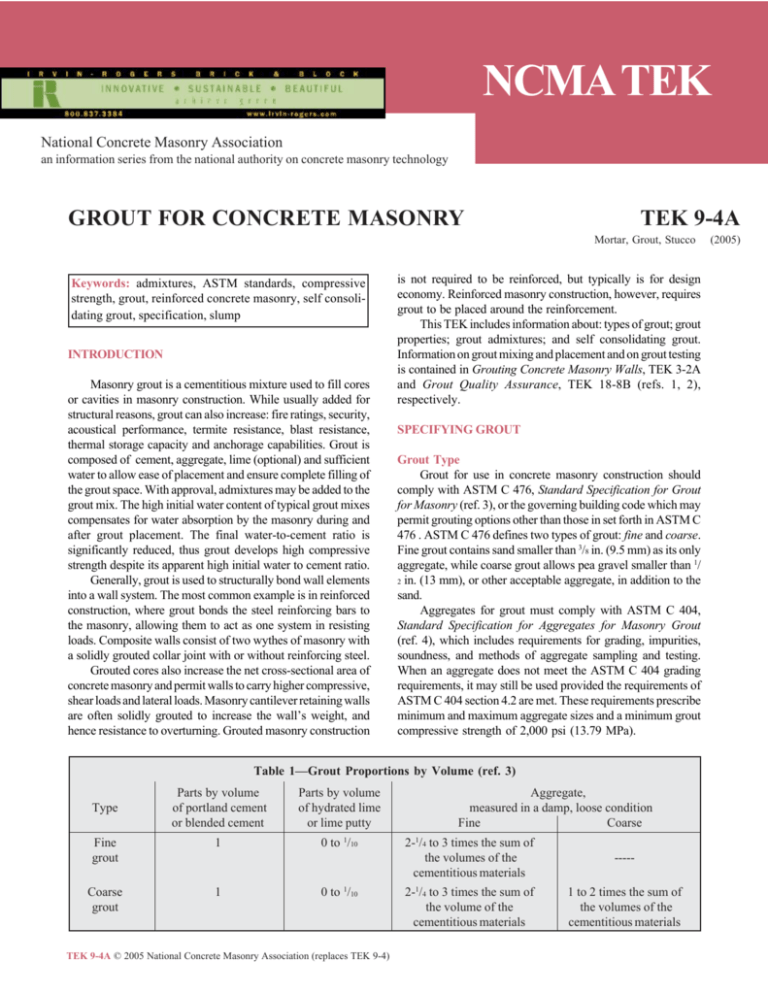
NCMA TEK National Concrete Masonry Association an information series from the national authority on concrete masonry technology GROUT FOR CONCRETE MASONRY TEK 9-4A Mortar, Grout, Stucco Keywords: admixtures, ASTM standards, compressive strength, grout, reinforced concrete masonry, self consolidating grout, specification, slump INTRODUCTION Masonry grout is a cementitious mixture used to fill cores or cavities in masonry construction. While usually added for structural reasons, grout can also increase: fire ratings, security, acoustical performance, termite resistance, blast resistance, thermal storage capacity and anchorage capabilities. Grout is composed of cement, aggregate, lime (optional) and sufficient water to allow ease of placement and ensure complete filling of the grout space. With approval, admixtures may be added to the grout mix. The high initial water content of typical grout mixes compensates for water absorption by the masonry during and after grout placement. The final water-to-cement ratio is significantly reduced, thus grout develops high compressive strength despite its apparent high initial water to cement ratio. Generally, grout is used to structurally bond wall elements into a wall system. The most common example is in reinforced construction, where grout bonds the steel reinforcing bars to the masonry, allowing them to act as one system in resisting loads. Composite walls consist of two wythes of masonry with a solidly grouted collar joint with or without reinforcing steel. Grouted cores also increase the net cross-sectional area of concrete masonry and permit walls to carry higher compressive, shear loads and lateral loads. Masonry cantilever retaining walls are often solidly grouted to increase the wall’s weight, and hence resistance to overturning. Grouted masonry construction is not required to be reinforced, but typically is for design economy. Reinforced masonry construction, however, requires grout to be placed around the reinforcement. This TEK includes information about: types of grout; grout properties; grout admixtures; and self consolidating grout. Information on grout mixing and placement and on grout testing is contained in Grouting Concrete Masonry Walls, TEK 3-2A and Grout Quality Assurance, TEK 18-8B (refs. 1, 2), respectively. SPECIFYING GROUT Grout Type Grout for use in concrete masonry construction should comply with ASTM C 476, Standard Specification for Grout for Masonry (ref. 3), or the governing building code which may permit grouting options other than those in set forth in ASTM C 476 . ASTM C 476 defines two types of grout: fine and coarse. Fine grout contains sand smaller than 3/8 in. (9.5 mm) as its only aggregate, while coarse grout allows pea gravel smaller than 1/ 2 in. (13 mm), or other acceptable aggregate, in addition to the sand. Aggregates for grout must comply with ASTM C 404, Standard Specification for Aggregates for Masonry Grout (ref. 4), which includes requirements for grading, impurities, soundness, and methods of aggregate sampling and testing. When an aggregate does not meet the ASTM C 404 grading requirements, it may still be used provided the requirements of ASTM C 404 section 4.2 are met. These requirements prescribe minimum and maximum aggregate sizes and a minimum grout compressive strength of 2,000 psi (13.79 MPa). Table 1—Grout Proportions by Volume (ref. 3) Parts by volume of portland cement or blended cement Parts by volume of hydrated lime or lime putty Fine grout 1 0 to 1/10 Coarse grout 1 Type 0 to 1/10 TEK 9-4A © 2005 National Concrete Masonry Association (replaces TEK 9-4) Aggregate, measured in a damp, loose condition Fine Coarse 2-1/4 to 3 times the sum of the volumes of the cementitious materials ----- 2-1/4 to 3 times the sum of the volume of the cementitious materials 1 to 2 times the sum of the volumes of the cementitious materials (2005) Building codes and ASTM Specifications do not recognize any appreciable compressive strength difference between fine and coarse grouts. The choice of grout type therefore depends primarily on the minimum clear dimensions of the grout space, the grout pour height and construction economics. Coarse grout is typically more economical to produce. See TEK 3-2A (ref. 1) for more information on grout space requirements and grout type selection. Grout Proportions ASTM C 476 allows grout mixtures to be determined either by compliance with the proportions listed in Table 1 or by those established through compressive strength testing. Written acceptance of grout mix submittals is required prior to the commencement of grouting operations (ref. 7). Using the proportions specified in Table 1 is a simple way to demonstrate compliance with ASTM C 476. When using the specified compressive strength method in ASTM C 476, the grout must be sampled and tested in accordance with ASTM C 1019 (ref. 5) and have a minimum compressive strength of 2,000 psi (13.79 MPa) at 28 days. It must also be mixed to a slump of 8 to 11 in. (203 - 279 mm) as determined by ASTM C 143/143M (ref. 6). The grout proportions used to produce a grout with acceptable physical properties are then used to produce the grout for the project. Compressive Strength While 2,000 psi (13.79 MPa) is the minimum compressive strength required by ASTM C 476, project requirements may require higher strengths. For instance, when the unit strength method is used to determine the specified compressive strength of the masonry, f'm, Specification for Masonry Structures (ref. 7) requires the compressive strength of the grout to equal or exceed f'm but not be less than 2,000 psi (13.79 MPa). As an economic rule of thumb, unless structural criteria dictate otherwise, it is best to balance the specified grout strength with the specified concrete masonry assembly strength so that one element of the system is not considerably stronger than the other, resulting in material overstrength and design conservatism. When using the strength design provisions of the Building Code Requirements for Masonry Structures (ref. 8), a maximum specified grout compressive strength of 5,000 psi (34.47 MPa) for concrete masonry construction is applied. This limitation is based solely on the specified compressive strength of grout and does not limit the actual field-tested grout compressive strength. Grout Slump Grout for masonry construction is a high slump material with a flowable consistency to ease placement and facilitate consolidation. Both the Specification for Masonry Structures (ref. 7) and ASTM C 476 require grout to have a slump between 8 and 11 in. (203 – 279 mm). Grout must be fluid enough to flow into the smallest grout spaces and around any obstructions, such as reinforcing bars, joint reinforcement, anchors, ties and small mortar protrusions (fins). Lower slump grouts are usually more difficult to place. Although the high slump (high initial watercement ratio of conventional grout) may concern those familiar with lower slump cementitious products such as concrete or mortar, concrete masonry units are absorptive, and the higher water content of grout is critical to insure that in-place grout has sufficient remaining water, after absorption by the masonry units, for cement hydration. Despite grout's relatively high water to cement ratio, studies have shown that adequate grout compressive strengths and bond strengths are achieved even when using high slump grouts in wet concrete masonry units (ref. 9). While both codes and standards specify grout slumps in excess of 8 in. (203 mm), there may be certain conditions where lower slumps could be used or may be warranted. For example, if the concrete masonry units are low absorptive units or if the grout spaces are large and the grout lifts are short, lower water content grouts may work fine although care should be taken to assure adequate filling around reinforcement or other obstructions. Likewise, cold weather could present conditions where lower water content grout would be advantageous under certain circumstances (i.e. freezing conditions), but not as a general rule. For demonstrating the suitability of alternate grouting means and/or methods, the grout demonstration panel option detailed in Specification for Masonry Structures (ref. 7) should be used to qualify the proposed method. See NCMA TEK 3-2A (ref. 1) for information on grout demonstration panels. Production Methods Production methods for grout are also described in ASTM C 476. These include various forms of site-mixed and readymixed grout. When cementitious materials and aggregates are stored separately on site and then proportioned into the mixer, they are required to be mixed for at least 5 minutes in a mechanical mixer with sufficient water to bring the grout to the desired consistency. Factory dry-blended cementitious materials and aggregate can also be delivered to the job site and must be mixed for the same 5 minute time period. Another option is for the individual dry ingredients to be shipped to the job site in compartments and then mixed with water on site using continuous proportioning equipment and auger mixing to the desired consistency. Grout also may arrive at the job site in a wet-mixed condition. Ready-mixed grout may have the slump adjusted at the site to bring it to the desired consistency. If water is added, the grout must be remixed for at least 1 minute before discharging. When approved by the specifier, grout may be mixed by hand instead of a mechanical mixer when only small volumes are required. Grout quantities required on a job can vary depending on the specific circumstances of the project. The unit properties, such as absorption and configuration, can have a significant impact. The delivery method (pumping versus bucketing) can also introduce different amounts of waste. Although the absolute volume of grout waste seen on a large project may be larger than on a comparable small project, smaller projects may experience a larger percentage of grout waste. Table 2 provides guidance for estimating grout quantities. ADMIXTURES A variety of admixtures is available to enhance certain grout properties. However, ASTM C 476 requires admixtures to be included in the project documents or to be approved by the purchaser. Likewise, Specification for Masonry Structures (ref. 7) requires admixtures to be accepted by the architect or engineer. Antifreeze compounds, used to lower the freezing point of grout, are prohibited by ASTM C 476. Admixtures containing chlorides should also not be used in grout, because chlorides may corrode steel reinforcement and can contribute to efflorescence in the wall. Several admixtures are available that provide a combination of desirable characteristics, such as shrinkage compensating, plasticizing and retarding. As with any admixture, manufacturer’s directions and dosage rates should be carefully followed. Note that individual admixture results can vary from one cement supplier to another. Shrinkage Compensators Shrinkage compensating admixtures cause a slow, controlled grout expansion that is intended to offset grout shrinkage due to the initial water loss. These admixtures may be especially useful for high-lift grouting, where a large volume of grout is placed and consolidated at one time. Superplasticizers Superplasticizing admixtures are used to reduce the water content of a plastic cementitious mix while maintaining high flow consistency. They are not normally used in conventional grout (except self-consolidating grout) since the excess water is absorbed into the masonry units. In some areas, however, this absorption of excess water has resulted in efflorescence problems. Superplasticizers have been found effective in reducing this problem by reducing the amount of water available for absorption. It should be noted however, that special formulation skills are required to ensure that the grout remains fluid long enough to completely fill all the voids. Fly Ash and Blast-Furnace Slag Fly ash is a by-product of coal combustion, and is not usually thought of as an admixture in the same sense as the chemical admixtures discussed above. Fly ash can be used in grout as a pumping aid or to provide a greater slump with less water. Fly ash can also replace some of the portland cement in the grout mix, which has an economic advantage since the unit cost of fly ash is less than that of portland cement. Addition rates of fly ash and raw natural pozzolans (ref. 10) or blast-furnace slag (ref. 11) are governed by ASTM C 595, Standard Specification for Blended Hydraulic Cements (ref. 12). These products can produce grout mixes with a slower initial strength gain, which may need to be considered in cold weather to achieve the minimum compressive strength previously discussed. Accelerators In grout, accelerating admixtures increase both the rate of hydration and the amount of heat generated during hydration. They are used in cold weather to decrease grout setting time and increase the rate of strength gain. The increased heat of hydration does not eliminate the need for cold weather protection requirements. Accelerators should be free of chloride materials and not perpetuate the corrosion of embedded metals. Retarders Retarding admixtures are used in hot weather to keep the grout workable long enough for placement, consolidation and reconsolidation. They may also be used when the grout cannot be placed right away, as may be the case when the plastic grout will travel a long distance to the job site. SELF-CONSOLIDATING GROUT A new grout material is becoming increasingly known in North American masonry markets – self-consolidating grout (SCG). SCG is a highly fluid and stable grout mix that is easy to Table 2—Grout Volume Estimationa Wall construction Hollow Hollow Hollow Hollow Hollow Hollow Hollow Hollow Hollow Hollow Hollow Hollow Hollow Hollow Hollow a Grout spacing 8 in. 16 in. 24 in. 32 in. 40 in. 48 in. 56 in. 64 in. 72 in. 80 in. 88 in. 96 in. 104 in. 112 in. 120 in Mortar bedding Full Face shell Face shell Face shell Face shell Face shell Face shell Face shell Face shell Face shell Face shell Face shell Face shell Face shell Face shell Volume of grout (ft3) per 100 ft2 of wall (m3 per 100 m2) for wall thickness: 6 inch 8 inch 10 inch 12 inch (152 mm) (203 mm) (254 mm) (305 mm) 25.6 (7.8) 12.8 (3.9) 8.6 (2.6) 6.4 (2.0) 5.2 (1.6) 4.3 (1.3) 3.7 (1.1) 3.2 (1.0) 2.9 (0.9) 2.6 (0.8) 2.4 (0.7) 2.2 (0.7) 2.0 (0.6) 1.9 (0.6) 1.8 (0.5) 36.1 (11.0) 18.1 (5.5) 12.1 (3.7) 9.1 (2.8) 7.3 (2.2) 6.1 (1.9) 5.2 (1.6) 4.6 (1.4) 4.1 (1.2) 3.7 (1.1) 3.3 (1.0) 3.1 (0.9) 2.8 (0.9) 2.6 (0.8) 2.5 (0.8) 47.0(14.3) 23.5 (7.2) 15.7 (4.8) 11.8 (3.6) 9.4 (2.9) 7.9 (2.4) 6.8 (2.1) 5.9 (1.8) 5.3 (1.6) 4.7 (1.4) 4.3 (1.3) 4.0 (1.2) 3.7 (1.1) 3.4 (1.0) 3.2 (1.0) 58.9 (18.0) 29.5 (9.0) 19.7 (6.0) 14.8 (4.5) 11.8 (3.6) 9.9 (3.0) 8.5 (2.6) 7.4 (2.3) 6.6 (2.0) 5.9 (1.8) 5.4 (1.6) 5.0 (1.5) 4.6 (1.4) 4.3 (1.3) 4.0 (1.2) Includes allowance for waste. Additional grout may be necessary for grouting horizontal courses of masonry, such as bond beams. place and does not require consolidation or reconsolidation. SCG’s mix design is significantly different from conventional grout. SCG is similar in nature to conventional grout, with the exception that the proportions of constituent materials are highly controlled and admixtures (typically in the form of superplasticizers with or without viscosity modifiers) are used to produce a plastic grout with desired properties. Controlled aggregate gradation is also important to maintain fluidity without segregation, to produce a mix that results in consistent properties throughout the grout lift. Because of the fluid nature of the material, traditional measures of consistency and flow such as the slump cone test (ASTM C 143) are not applicable to SCG. A slump flow test is used instead, which is an adaptation of the conventional slump cone test. In the slump flow test, SCG is loaded into an inverted slump cone. The cone is removed and the flow of the material is observed and measured. Typical slump flow spreads for SCG range from 20 to 30 in. (508-762 mm). Indications of bleeding or segregation should not be seen in the flow spread. SCG is a relatively new material so it is not yet incorporated into building codes and standards. To date, compliance has been achieved in several cases by using the grout demonstration panel option in Specification for Masonry Structures (ref. 7). Work is under way to standardize and codify this material. REFERENCES 1. Grouting Concrete Masonry Walls, TEK 3-2A. National Concrete Masonry Association, 2005. 2. Grout Quality Assurance, TEK 18-8B. National Concrete Masonry Association, 2005. 3. Standard Specification for Grout for Masonry, ASTM C 476-02. ASTM International, 2002. 4. Standard Specification for Aggregates for Masonry Grout, ASTM C 404-04. ASTM International, 2004. 5. Standard Test Method for Sampling and Testing Grout, ASTM C 1019-03. ASTM International, 2003. 6. Standard Test Method for Slump of Hydraulic-Cement Concrete, ASTM C 143/143M-03. ASTM International, 2003. 7. Specification for Masonry Structures, ACI 530.1-05/ASCE 6-05/TMS 602-05. Reported by the Masonry Standards Joint Committee, 2005. 8. Building Code Requirements for Masonry Structures, ACI 530-05/ASCE 5-05/TMS 402-05. Reported by the Masonry Standards Joint Committee, 2005. 9. The Effects of Concrete Masonry Unit Moisture Content on Grout Bond and Grout Compressive Strength, MR 11. National Concrete Masonry Association Research and Development Laboratory, 1997. 10. Standard Specification for Coal Fly Ash and Raw or Calcined Natural Pozzolan for Use in Concrete, ASTM C 61803. ASTM International, 2003. 11. Standard Specification for Ground Granulated Blast-Furnace Slag for Use in Concrete and Mortars, ASTM C 98905. ASTM International, 2005. 12. Standard Specification for Blended Hydraulic Cements, ASTM C 595–03. ASTM International, 2003. Provided by: NCMA and the companies disseminating this technical information disclaim any and all responsibility and liability for the accuracy and the application of the information contained in this publication. NATIONAL CONCRETE MASONRY ASSOCIATION 13750 Sunrise Valley Drive, Herndon, Virginia 20171 www.ncma.org To order a complete TEK Manual or TEK Index, contact NCMA Publications (703) 713-1900
